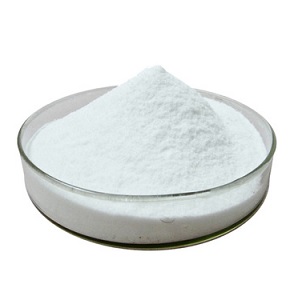| Identification | More | [Name]
Cetylpyridinium chloride | [CAS]
123-03-5 | [Synonyms]
1-HEXADECYLPYRIDINIUM CHLORIDE
CETYLPYRIDINIUM CHLORIDE
CETYL PYRIDINIUM CHLORINE
HEXADECYL PYRIDINIUM CHLORIDE
N-HEXADECYLPYRIDINIUM CHLORIDE
1-cetylpyridiniumchloride
1-hexadecyl-pyridiniuchloride
1-palmitylpyridiniumchloride
acetoquatcpc
aktivex
ammonyxcpc
biosept
ceeprinchloride
ceepryn
ceeprynchloride
cepacol
cepacolchloride
ceprim
cetamium
dobendan | [EINECS(EC#)]
204-593-9 | [Molecular Formula]
C21H38ClN | [MDL Number]
MFCD00011731 | [Molecular Weight]
339.99 | [MOL File]
123-03-5.mol |
| Chemical Properties | Back Directory | [Appearance]
white powder or crystals with a pyridine-like odour | [Melting point ]
77°C | [Boiling point ]
496.25°C (rough estimate) | [density ]
0.9362 (rough estimate) | [vapor pressure ]
0Pa at 25℃ | [refractive index ]
1.6000 (estimate) | [storage temp. ]
Inert atmosphere,Room Temperature | [solubility ]
Freely soluble in water; very soluble in chloroform;
very slightly soluble in ether; insoluble in acetone, acetic acid,
and ethanol. | [form ]
White Crystalline Powder | [color ]
White to off-white | [Odor]
at 100.00?%. pyridine | [Stability:]
Stable. Combustible. Incompatible with strong oxidizing agents, strong bases. | [Water Solubility ]
111g/L at 20℃ | [LogP]
1.71 at 20℃ | [Uses]
Antibacterial in cough lozenges and syrups;
emulsifier.
| [CAS DataBase Reference]
123-03-5(CAS DataBase Reference) | [EPA Substance Registry System]
123-03-5(EPA Substance) |
| Safety Data | Back Directory | [RIDADR ]
2811 | [HazardClass ]
6.1(b) | [PackingGroup ]
III | [HS Code ]
2933399990 | [Safety Profile]
Poison by ingestion,
intraperitoneal, subcutaneous, and
intravenous routes. Moderately toxic by skin
contact. A skin and eye irritant. When
E heated to decomposiuon it emits very toxic
fumes of NOx and Cl-. | [Hazardous Substances Data]
123-03-5(Hazardous Substances Data) |
| Hazard Information | Back Directory | [Description]
Cetylpyridinium is a quaternary ammonium with broad-spectrum antiseptic activities.1 It is active against S. mutans, S. sanguis, E. coli, Oxford Staphylococcus, and C. albicans in media (MICs = 1.25-62.5 μg/ml) and against Oxford Staphylococcus in pooled human saliva (MICs = 7.8-15.6 μg/ml).2 Cetylpyridinium slows plaque formation for at least 21 days compared to a deionized water control in a rat incisor plaque model when applied topically at concentrations ranging from 0.025 to 2%.3 Formulations containing cetylpyridinium have been used as antiseptic agents in the treatment of gingivitis and as antimicrobial agents in raw food processing. | [Chemical Properties]
Cetylpyridinium chloride (CPC) is a white powder or crystals with a characteristic odor. It is slightly soapy to the touch.

Cetylpyridinium chloride is a quaternary ammonium compound and is the active chemical in some human mouthwashes on the market. It has antiseptic properties and is used in solutions or lozenges for the treatment of minor infections of the mouth and throat. The antimicrobial activity is due to an interaction of basic cetylpyridinium ions with acidic molecules on bacteria, which subsequently inhibits bacterial metabolism by forming weak ionic compounds that interfere with bacterial respiration.
| [Definition]
ChEBI: A pyridinium salt that has N-hexadecylpyridinium as the cation and chloride as the anion. It has antiseptic properties and is used in solutions or lozenges for the treatment of minor infections of the mouth and throat. | [Production Methods]
Cetylpyridinium chloride is prepared from cetyl chloride by
treatment with pyridine. | [Brand name]
Ceepryn (Marion Merrell
Dow); Cepacol (Marion Merrell Dow). | [Flammability and Explosibility]
Nonflammable | [Pharmaceutical Applications]
Cetylpyridinium chloride is a quaternary ammonium cationic
surfactant, used in pharmaceutical and cosmetic formulations as
an antimicrobial preservative. It is used therapeutically
as an antiseptic agent; used alone or in combination with
other drugs for oral and throat care; used in nonparenteral
formulations licensed in the UK; and used in oral and inhalation
preparations at concentrations of 0.02–1.5 mg.
Mouthwashes containing cetylpyridinium chloride have been
shown to inhibit plaque formation,(1–3) although efficacy is variable
owing to limited published data. | [Clinical Use]
1-Hexadecylpyridinium chloride is a white powder that isvery soluble in water and alcohol. In this compound, thequaternary nitrogen atom is a member of an aromatic pyridinering.
The cetyl derivative is the most active of a series ofalkylpyridinium compounds. It is used as a general antisepticin concentrations of 1:100 to 1:1,000 for intact skin,1:1,000 for minor lacerations, and 1:2,000 to 1:10,000 forthe irrigation of mucous membranes. Cetylpyridinium chlorideis also available in the form of throat lozenges and amouthwash at a 1:20,000 dilution. | [Safety]
Cetylpyridinium chloride is used widely in mouthwashes as a
bactericidal antiseptic. It is generally regarded as a relatively
nontoxic material when used at a concentration of 0.05% w/v,
although minor side effects such as mild burning sensations on the
tongue have been reported.
At higher concentrations, cetylpyridinium chloride may damage
the mucous membranes in the mouth. It is harmful when ingested or
inhaled. It can cause eye irritation, and is irritant to the respiratory
system and the skin.
LD50 (rat, IP): 0.006 g/kg
LD50 (rat, IV): 0.03 g/kg
LD50 (rat, oral): 0.2 g/kg
LD50 (rat, SC): 0.25 g/kg
LD50 (mouse, IP): 0.01 g/kg
LD50 (mouse, oral): 0.108 g/kg
LD50 (rabbit, oral): 0.4 g/kg
LD50 (rabbit, IV): 0.036 g/kg | [storage]
Cetylpyridinium chloride is stable under normal conditions. It
should be stored in well-closed containers. | [Incompatibilities]
Incompatible with strong oxidizing agents and bases. It is also
incompatible with methylcellulose.
Magnesium stearate suspensions in cetylpyridinium chloride
have been shown to significantly reduce its antimicrobial activity.
This is due to the absorption of cetylpyridinium chloride on
magnesium stearate. The cetylpyridinium chloride ion also
interacts with gelatin, resulting in reduced bioavailability. | [Toxics Screening Level]
The Initial threshold Screening Level (ITSL) is 1.8 μg/m3 based on annual averaging. | [Regulatory Status]
Included in nonparenteral formulations licensed in the UK. Included
in the FDA Inactive Ingredients Database, for use in inhalation and
oral preparations. Reported in the EPA TSCA Inventory. It is not
approved for use in Japan. Included in the Canadian List of
Acceptable Non-medicinal Ingredients. |
|
|